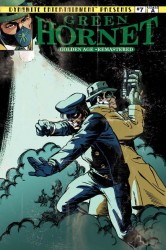With the impending release of the Green Hornet film, Dynamite Entertainment is reprinting some of the classic Green Hornet stories for readers to enjoy before the movie. Read this review to find out whether these stories stand the test of time or read like a crude relic of the past.

Covers: Joe Rubinstein
Writer: Fran Striker
Penciller/Inker: Bert Whitman Associates
Publisher: Dynamite Entertainment
Price: $3.99
Britt Reid is the publisher of one of the most powerful newspapers in the city, The Daily Sentinel. However, growing tired of his posh, playboy ways, Reid decides to use his publishing experience and knowledge of the city’s crime syndicate for the benefit of a victimized society. He dedicates his life to taking down crime under the guise of The Green Hornet!
Simple Stories Told With Wit And Charm
The Green Hornet Golden Age Remastered #7 is a reprinting of The Green Hornet Comics #4-5 that were published in 1940. These stories were written in a time before comics were licensed properties and t-shirt logos. Stories during this time didn’t follow a dogmatic view on a character’s continuity or involve multi-part story-arcs. Instead these Green Hornet stories were quaint tales that were told concisely with a lot of passion and an eye for fun.
Fran Striker, who was also the writer and creator of The Lone Ranger, was the creator of the original Green Hornet radio show and the writer for these stories. The Green Hornet stories collected in this reprinting run about 6-8 pages in length and deal with nefarious mob activity, a subway bomber and a crazed derelict brandishing a whip. There is usually a damsel in distress and the villains seem to spend more time talking about their schemes rather than actually acting on them. And, of course, The Green Hornet is always there in the nick of time.
Admittedly the stories aren’t going to be classified as great literature and, in some cases, can even elicit some unintentional laughter. They lack sophistication, have very stilted dialogue and even include spelling mistakes. However, there is a charm to these issues that is undeniable. These books act more as a time capsule or conversation piece than anything. Sure the stories are predictable and sometimes shallow, but the writers at this time also didn’t have the luxury of years of comic evolution to draw upon.
These early Green Hornet stories are the essence of comics. They include a brave, self sacrificing hero, wicked villains, a good looking woman and some cool gadgets. It never gets old to see the Green Hornet uppercut every thug in the room all while spouting a quip for each of them. There is an element of pure fun, hope and adventure that is lacking in today’s overly gritty world of comics.
Art That Tells A Story
Comic book art during this time served one purpose: tell the story! You’re not going to find any painted covers or variant editions in these stories and there aren’t any flashy splash pages. Instead you’re going to find a city crafted with such atmosphere that it seems like a perfect breeding ground for crime. There are also fight scenes that pull back and let the reader feel every haymaker and judo throw in the story. The art brings a noir tone to the book that really adds to the ambience.
There are also no washed out or “real world” colors used in these stories. The yellows, reds and greens are all vibrant, giving the reader a sense that these characters live in a fantastical world that is similar to our own, but not quite the same. This is art in a time when characters didn’t have hundreds of pouches on their costume and no artist would use Kate Beckinsale as the model for their character’s face. This is street level art that has a real story to tell.
Bottom Line: Buy It If You’re Interested In History
What’s great about these stories is that they offer a glimpse into the early days of the comics industry. So go ahead and buy this issue if you are curious about older comics and want to see what the inspiration was for the issues on the shelves now. Or buy it if you know what to expect and just want the thrill of reading an old comic again. These were simpler stories during a simpler time as comics took their first baby steps out of the primordial ooze of publishing.
[rating:4/5]


